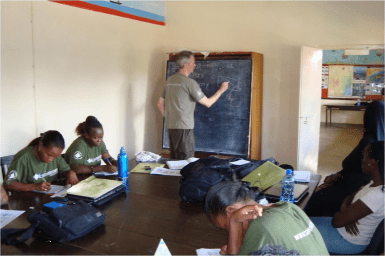By Lalao Aigrette Ravaoarinorotsihoarana, Mangrove REDD Research Manager, Blue Ventures Conservation.
Earthwatch is an international NGO which runs a training program to enhance local and regional research capacity and has been supporting mangrove research in Kenya through the Tidal Forests of Kenya project since 2003. I was awarded an Earthwatch fellowship, supported by the John Ellerman Foundation, to participate in the project from 4th -14th June 2011. Ten fellows across Kenya, Tanzania, Mozambique and Madagascar had been recruited for a 10 day course on Management of Mangroves using Payment for Ecosystem Services. PES schemes effectively use sustainable financing to reward those whose land provides services from nature.
The training and its related activities were centred on Gazi Bay mangroves and facilitated by the Kenya Marine and Fisheries Research Institute (KMFRI) field station at Gazi. The course was run by Earthwatch Scientists Dr James Kairo and Dr Martin Skov who were assisted by project staff, including: Joseph Langat, Caroline Wanjiru, Amina Juma, Micheal Githaiga, Tabitha Muriuki and Alfred Obinga.

Earthwatch training
In regards to climate change mitigation, mangroves play an important role thanks to their significant capacity to sequester CO2. However, mitigation requires reducing carbon emission and /or increasing absorption capacity, which means effective mangrove management through reforestation combined with the avoidance of deforestation and forest degradation (REDD). The effective conservation of mangrove forests has the potential to generate carbon credits, and the sale of these credits on international carbon markets can bring significant project financing and greatly increase the financial value of these habitats.
“Mikoko Pamoja” (which means “mangroves together”) is a community led-project at Gazi Bay which is pioneering the way for the adaptation of REDD financing schemes for mangroves. The project aims to channel finance to the protection and restoration of mangrove ecosystems in Kenya through the provision of, and payment for, quantifiable ecosystem services. To achieve these targets, the project plans to apply the following objectives: (i) Protect 107 ha of the current forest from further degradation, (ii) Reforest degraded areas and maintain nurseries – replant 1 ha/yr and establish a Casuarina (a fast growing tree species) plantation of 3000 trees on community land close to Gazi village. The establishment of this plantation will help to prevent carbon leakage, by providing a source of firewood and timber for local people to replace the material currently taken from the mangroves. From these activities, the project is expecting to produce about 2023 tCO2 per year which will provide a potential income of approximately $12,138 from carbon credits. The people living in the surrounding Gazi Bay area, the local organization and the external groups supporting the project all aim to benefit from Mikoko Pamoja.
My ambition is to replicate Mikoko Pamoja in my home country, Madagascar, where many of our mangrove forests are already degraded and are in need of restoration and a sound management plan. The Mikoko Pamoja project is an excellent model for promoting a PES scheme which aims to protect the mangrove ecosystem while at the same time enabling significant local development projects. I hope that I will be able to apply the skill and experiences I gained from the training in Kenya to the mangrove REDD project we are undertaking in Madagascar. In this project, we hope to quantify the net CO2 sequestered in an extensive mangrove forest that is experiencing deforestation and also to demonstrate the value of mangroves in mitigating climate change. Additionally, we aim to demonstrate the potential financial value of particular mangrove to decision makers.
I am grateful to the John Ellerman Foundation, through the Earthwatch Institute, for awarding me the fellowship. Also, I would like to give my thanks to the trainers for providing me with the skills, experience and knowledge which will greatly contribute in my future career. Deepest thanks to the Earthwatch fellow, Team 1-2011.

Earthwatch volunteer team 2011. Lalao front row, 5th from the right.

